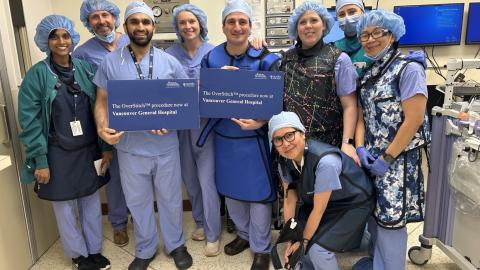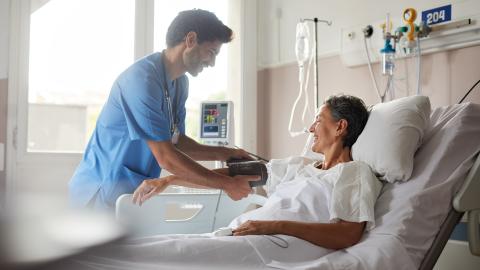Breast reconstruction surgery information
Information including surgery time, complications and photos for the following common methods of breast reconstructive surgery.
Photos
Before and after photos of reconstruction surgeries
Before-and-after surgery photos follow descriptions of the different methods. These photos may upset some people. However, the intent is to inform women who are in the process of deciding whether to undergo breast reconstruction. If you feel that the photos may distress you, please do not view them.
Breast reconstruction before and after photos
Reconstruction surgery complications
This is intended for education of homecare nurses and medical personnel to help them recognize the rare but significant complications associated with various methods of breast reconstruction. If you feel that you may be distressed by the contents of these pages, please do not view.
Breast Reconstruction complication photos
Tissue Expanders (Alloplastic Reconstruction)
Tissue expanders (adjustable implants) are placed behind the chest muscle (pectoralis muscle) to stretch the muscle and skin until the new breast mound reaches a slightly larger size than the natural breast. The partially inflated expander is inflated in stages weeks following surgery after the surgical site has healed. Small amounts of saline solution (salt water) inflate the expander via an incorporated valve. A second surgery (outpatient surgery) is required to remove the expander and replace it with a permanent breast implant. Some expanders are designed to be left in place and are not replaced with an implant.
Advantages of this procedure
The expander procedure allows for improved success in matching the shape and sag of the opposite breast. Bilateral (both breasts) reconstruction allows more flexibility in selecting breast size.
Disadvantages of this procedure
Tissue expansion may require a few months of frequent doctors' appointments to complete the inflation process.
Surgery time, hospital stay, pain and return to normal activities
The surgery takes about 2 hours, depending on whether it is delayed or immediate, unilateral (one side) or bilateral (both sides) reconstruction and whether the remaining breast requires reduction or lifting (mastopexy) surgery.
-
The hospital stay is one day.
-
The pain with this procedure is described as a sensation of tightness in the chest area. This tightness occurs because of pressure on the muscle as the expander bag has been inflated with some saline before it is placed. When the device is expanded again in the surgeon’s office, the sensation of tightness will return and last for about 1 to 2 days, disappearing as the newly stretched skin relaxes.
-
Most women return to work or normal activities within 2 to 4 weeks.
Possible complications
It is important to know that complication rates decrease as plastic surgeons develop more expertise in the surgery and that complications with breast reconstruction are similar to those associated with any surgery.
- Bleeding (hematoma)
- Problems with a general anesthesia
- Seroma (collection of fluid under the wound)
- Infection - Although significant wound infections are rare when they do occur, antibiotics are used to treat them. However, if the infection persists, the implant may have to be removed, and when this happens, further reconstructive attempts should be delayed a minimum of 3 months.
- Capsular contracture - Fibrous tissue may form around the implant, causing tightening, hardening, and change in implant shape. Capsular contracture may occur within months or years after reconstruction. In some cases, removing the implant and replacing it with a new one may be necessary. There is a higher incidence of capsular contracture if radiation is involved.
- Implant displacement or rupture - This may occur, and surgery to replace the implant may be required. Mammography, ultrasound and MRI can be used to investigate a suspected rupture. However, the only certain method to establish that a rupture has occurred is a surgical investigation.
- Breast asymmetry - The most common shortfall for implant reconstruction is the difficulty of matching the opposite breast in shape, size, and sensation with the implant devices currently available.
- Delayed wound healing caused by smoking.
- Thinning of the stretched skin may cause wound-healing problems.
- Valve problems can also occur.
* Radiation before or after the mastectomy surgery increases the risk of complications.
Implants (Alloplastic Reconstruction)
The simplest reconstruction method is a breast implant under the chest muscle to create a breast mound. This can be done either at the time of the mastectomy or later. This method is suitable when the opposite breast is small and non-sagging. Because the chest muscle has to be present, this method is inappropriate for women who have had radical mastectomies.
Disadvantages
Implants will not last a lifetime. The life span varies, and they may have to be replaced or adjusted as women age and the appearance of the natural breast changes.
There are limits to the size of the breast that can be reconstructed using implants. Larger implants may require additional surgery because of problems related to symmetry and changes in the overlying soft tissue that takes place over time.
Two types of implants
In Canada, two types of implants are used. Saline implants (implant bags filled with salt water) and silicone gel implants. Silicone gel implants are available only with approval from Health Canada.
Saline implants
Saline implants have been used most frequently over the last ten years. However, problems do exist: wrinkling, rupture and capsular contracture. If the implant ruptures, the surrounding tissues will absorb the saline within about 48 hours. The implant will need to be removed and replaced within a few weeks after rupture.
A multi-centre study reviewed the outcome of saline-filled breast implants and defined the expected life span of these implants. Excluding accidental deflation, the expected life span was established to be 98.8 to 99.5% at five years and 97.9 to 99.5% at ten years (Cunningham, BL, Lokeh A, & Gutowski KA).
Silicone gel implants
The silicone gel implant provides a softer and more natural breast shape and makes the implant less visible and palpable.
The safety of silicone gel implants has been confirmed by a number of studies over the past ten years. No evidence was found to indicate that silicone implants were associated with a significant increase in health problems (autoimmune diseases such as arthritis, systemic lupus, etc.)
* Being informed about breast reconstruction is important. For further information about implants go to the Health Canada Breast Implant website.
Possible complications
It is important to know that complication rates decrease as plastic surgeons develop more expertise in doing the surgery and that complications with breast reconstruction are similar to those associated with any surgery.
- Bleeding (hematoma)
- Problems with a general anesthesia
- Seroma (collection of fluid under the wound)
- Infection - Although significant wound infections are rare, when they do occur antibiotics are used to treat them. However, if infection persists, the implant may have to be removed and when this happens, further reconstructive attempts should be delayed a minimum of 3 months.
- Capsular contracture - Fibrous tissue may form around the implant cause tightening and hardening and change the implant shape. Capsular contracture may occur within months or years after reconstruction. In some cases, it may be necessary to remove the implant and replace it with a new one.
- Implant displacement, rupture - If these complication occur, surgery to replace the implant may be required. Mammography, ultrasound and MRI can be used to investigate a suspected rupture. However, the only certain method to establish that a rupture has occurred is surgical investigation
- Breast asymmetry - The most common shortfall for implant reconstruction is the difficulty of matching the opposite breast in shape, size, and sensation with the implant devices currently available.
- Delayed wound healing caused by smoking
- Thinning of the stretched skin may cause wound healing problems.
* Radiation before or after the mastectomy surgery increases the risk of complication.
Tissue Transfer (Autologous Reconstruction)
Tissue transfer breast reconstruction involves tissue moving from the abdomen, back, upper buttocks or thigh (donor sites) area to the chest using two different techniques.
The most common donor sites from which muscle, fat and skin are moved are the 1) abdomen or 2) upper back area, 3) buttocks, and 4) inner thigh areas. The names of the procedures correspond to the area from which the tissue is moved.
Two techniques
Pedicled flap technique
This technique involves tunnelling muscle, fat and a skin flap from the donor site ( abdomen or back) to the breast area while still attached to its blood supply.
Free flap technique
This technique involves detaching and lifting fat and/or muscle, a skin flap, and moving the flap to the breast area. The flap's blood vessels are reattached to those under the arm or in the chest by microsurgery. The free flap technique adds about three additional hours to the surgery time.
The disadvantage of the free flap technique is the increase in surgical time and a small risk (1 -7%) of complete flap loss. The advantage of this free flap technique is that the skin and fat can sometimes be removed without any muscle, decreasing the risk of a post-operative abdominal hernia.
Advantages of the tissue transfer procedure
- A more natural-feeling breast may be created using the body's tissue. Women who prefer not to have foreign materials such as implants in their bodies often choose one of these methods. As well, specific breast shapes are easier to match with tissue transfer. When the abdominal tissue is used, women get the bonus of a "tummy tuck"(abdominoplasty).
- The individual’s tissue is used and will grow if weight gain or loss occurs.
- Many tissue transfer reconstructions can be done without implants, so no artificial material is placed in the body.
Disadvantages of the tissue transfer procedure
- Recovery time is longer than the expander/implant procedure.
- If blood flow problems develop, all or part of the reconstructed breast may be lost.
- Permanent or temporary weakness may occur in the area from which the muscle was transferred (TRAM only).
- There will be additional abdominal, back, upper buttocks or thigh scars.
- When women have slender bodies and not enough tissue to create breast mounds, implants are sometimes needed with the TRAM or, more often, with the latissimus dorsi flaps.
TRAM
TRAM pedicled flap technique
A flap of muscle and fat with some overlying skin attached is taken from the lower abdominal area, rotated and moved through a tunnel to the chest area, where it is stitched in place.
TRAM free flap technique
The muscle, fat and skin are lifted, detached and then moved to the breast area. Microsurgery is used to reattach the flap's blood vessels to those under the arm.
Immediate reconstruction
With a skin-sparing mastectomy and immediate reconstruction, all the breast skin is preserved except a small portion that is removed with the nipple and areola, as well as any biopsy scars. The removed skin is replaced with abdominal skin from the TRAM flap.
The scar to the breast area varies and depends on several factors, the most important being the timing of surgery. In the case of immediate reconstruction, the previous biopsy scar and its location relative to the nipple-areola complex (NAC) determine the scars.
Delayed reconstruction
With delayed reconstruction, the plastic surgeon reopens the mastectomy incision, which requires a more extensive section of replacement skin from an oval-shaped patch of abdominal skin.
The scar on the abdominal area is horizontal, above the pubic bone, similar but slightly higher than the scarring from a "tummy tuck."
Surgery time, hospital stay, pain and return to normal activities
- The surgery takes about 3 to 4 hours, depending on whether it is delayed or immediate, unilateral (one side) or bilateral (both sides) reconstruction and whether the remaining breast requires reduction or lifting (mastopexy) surgery.
- A hospital stay of 3 days is required.
- Drains (small tube) are needed in the breast as well as abdome. These are removed once the drainage has decreased to an amount specified by the surgeon.
- It takes about 6 to 12 weeks to recover and resume normal activities or return to work after TRAM flap surgery
- Women describe the pain associated with this method as a sensation of tightness, pulling and numbness in the abdominal and rib cage area. The tightness and pulling diminishes within 1 to 3 months when the muscles stretch out, but the feeling of numbness takes longer to improve, about 6-18 months. If you had an axillary node dissection (glands removed from your armpit to see if the cancer has spread) you may also have some numbness in the upper, inner arm.
Possible complications
TRAM flap reconstruction is complex surgery; as a result there are more possibilities for complications.
- Problems with a general anesthesia
- Delayed Wound Healing - Approximately 10% of women experience delayed wound healing because of insufficient blood supply to a small area in the breast or the abdominal area.
- Fat Necrosis - Sometimes the blood supply to a small portion of fat will be insufficient causing firmness of the fatty tissue (fat necrosis). This occurs in about 8 to 15% of patients. Fat necrosis can be surgically removed when the nipple is reconstructed.
- Seromas - Fluid collection (seromas) in the abdominal wound may also occur. The plastic surgeon may have to remove the fluid with a syringe or place a drain through the incision.
- TRAM flap blood circulation problems - Partial flap loss (necrosis) sometimes occurs when the blood supply to the TRAM flap is inadequate. Complete loss of the TRAM flap due to poor blood supply does not usually occur in the pedicle procedure. However, with the free TRAM flap technique, the loss is approximately 2-7%.
- Bleeding (hematoma or blood clot) - Bleeding or hematoma can occur in the reconstructed breast, the opposite breast if a reduction surgery was done or the abdominal area. If the hematoma is large, surgery will be required to remove the clot.
- Infection - Infection, a rare complication, occurs more frequently in women who smoke, have had radiation, or are overweight.
- Abdominal Herniation (bulge) - Another rare complication is an abdominal bulge after TRAM flap surgery. The risk of this increases when both abdominal muscles (rectus muscles) are used for bilateral reconstruction and in women who are overweight. For bilateral reconstruction cases, thought to be at higher risk for developing a hernia or bulge, the surgical mesh may be used in an attempt to prevent this complication. Patients should protect their stomach muscles for three months after the surgery by avoiding lifting heavy objects or doing strenuous activities which involve using the stomach muscles.
- Blood clots (DVT or deep vein thrombosis/ PE or pulmonary embolus)
- Blood clots in the legs that can travel to the lungs are a rare complication in most surgical procedures. Activity to enhance blood flow such as: getting out of bed soon after the surgery and wearing elastic stockings and using sequentially compressive stocking while in bed will lessen the chance of deep vein thrombosis.
DIEP flap
The deep inferior epigastric artery perforator flap is similar to the transverse rectus abdominis muscle flap (TRAM). This flap uses the tissue and fat from the abdominal area. However, the rectus muscle is left intact. The risk of developing a post-operative bulge or hernia is therefore reduced.
During the procedure, small vessels from the deep inferior epigastric artery that perforate through the rectus muscle are identified. One to two of these perforators is then traced through the rectus muscle to their origin from the deep inferior epigastric artery. The skin and fat from the abdomen are then removed with the vessel(s), leaving the rectus muscle intact.
The flap is then transferred to the chest wall. The vessels that supply blood to the flap are attached to the internal mammary artery and vein, which lie under the ribs next to the sternum. A small (2cm) portion of the third rib costal cartilage is removed to reveal the underlying vessels. A microscope is then used to help the surgeon visualize the vessels so they can be sutured together.
Surgery time, hospital stay, pain and return to normal activities
- The surgery is 6-8 hours long depending on whether it is delayed or immediate, unilateral (one side) or bilateral (both sides) reconstruction and whether the remaining breast requires reduction or lifting (mastopexy) surgery.
- Patients stay in hospital for 3-5 days and require frequent checks of the flap by the ward nurses to evaluate blood flow
- Patients may have pain and/or a sensation of tightness around the new breast, rib cage and donor site. If an axillary node dissection (glands removed from the armpit to see if the cancer has spread) was done, there may also be some numbness in the upper, inner arm.
- Patients are unable to drink caffeine for one month after the surgery and must take aspirin once per day for a month.
- Drains are placed in the breast as well as abdomen and these are removed usually about 7 days after the surgery once the drainage has decrease to an amount specified by the surgeon.
- Patients are restricted from exercise or heavy activity for a period of 4-6 weeks.
- A special soft bra is worn 24 hours per day for the first 4 weeks.
Possible complications
- Problems with a general anesthesia
- Flap failure (1-2%.)
- Wound healing complications - Wound healing occurs when there is insufficient blood supply to a small area of tissue.
- Bleeding (hematoma or blood clot 1-2% - Hematoma can occur in the reconstructed breast, opposite breast if a reduction surgery was done or the abdominal area
- Infection (1-2%) - Infection, a rare complication in all surgical procedures, occurs more frequently in women who smoke, who have had radiation or who are diabetic.
- Fat Necrosis - Sometimes the blood supply to a small portion of fat will be insufficient causing firmness of the fatty tissue (fat necrosis). This occurs in about 8 to 15% of patients. Fat necrosis can be surgically removed when the nipple is reconstructed.
SGAP flap
The SGAP flap is also a perforator flap. This flap relies on the blood vessels that penetrate the gluteus maximus muscle, the superior gluteal artery and the vein. The flap is taken from the upper buttock area. It includes skin and fat, but no muscle is taken. The scar is on the upper part of the buttock in an oblique orientation.
Because of the technical difficulty of the operation, it is reserved for patients who are not candidates for the DIEP or TRAM flap.
Surgery time, hospital stay, pain and return to normal activities
- This surgery takes 8 hours. depending on whether it is delayed or immediate, unilateral (one side) or bilateral (both sides) reconstruction and whether the remaining breast requires reduction or lifting (mastopexy) surgery.
- Patients must stay in bed for the first two days following surgery to prevent tension on the buttock incision.
- Patients may have pain and/or a sensation of tightness around the new breast and donor site. If an axillary node dissection (glands removed from the armpit to see if cancer has spread) was done, there might also be numbness in the upper, inner arm.
- Flexion of the hips is minimized for the first two weeks following surgery
- Drains are needed in the breast and buttocks; these are usually removed about seven days after the surgery once the drainage has decreased to an amount specified by the surgeon.
- Patients stay in the hospital for 3-5 days and require frequent checks of the flap by the ward nurses to evaluate blood flow.
- Exercise or heavy activity is restricted for 4-6 weeks after the surgery.
- Patients cannot drink caffeine for one month after the surgery and must take aspirin once daily for a month.
- A soft bra is worn 24 hours daily for the first four weeks.
Possible complications
- Problems with a general anesthesia
- Total flap failure (about 1-2%.)
- Wound healing complications - Wound healing occurs when insufficient blood supply to a small tissue area.
- Bleeding (hematoma or blood clot) (1-2% - Hematoma occurs in the reconstructed breast, opposite breast if a reduction surgery was done or the abdominal area.
- Infection (1-2%)
- Fat Necrosis - Sometimes, the blood supply to a small portion of fat will be insufficient, causing firmness of the fatty tissue (fat necrosis). This occurs in about 8 to 15% of patients. Fat necrosis can be surgically removed when the nipple is reconstructed.
TUG flap
The TUG flap is taken from the inner thigh and stands for the “Transverse Upper Gracilis” flap. Skin, fat and a portion of the gracilis muscle are used to reconstruct the breast. This surgery leaves a visible scar in the groin just beneath the underwear line. Patients usually require liposuction of the contralateral thigh to achieve symmetry.
Surgery time, hospital stay, pain and return to normal activities
- This surgery takes 3-4 hours depending on whether it is delayed or immediate, unilateral (one side) or bilateral (both sides) reconstruction and whether the remaining breast requires reduction or lifting (mastopexy) surgery.
- Drains are needed in the breast and the thigh; these are usually removed about seven days after the surgery once the drainage has decreased to an amount specified by the surgeon.
- Patients must stay in bed for the first 2-3 days following surgery and require frequent checks of the flap by the ward nurses to evaluate blood flow.
- Patients may have pain and/or a sensation of tightness around the new breast and donor site. If an axillary node dissection (glands removed from your armpit to see if cancer has spread) was done, there might also be numbness in the upper, inner arm.
- Patients cannot drink caffeine for one month after the surgery and must take aspirin once daily for a month.
Nipple reconstruction
Nipple reconstruction is most commonly done 3 to 6 months after breast reconstruction allowing time for the breast mound to heal and settle into its final shape and position. This allows the plastic surgeon to position the nipple in line with the nipple on the natural breast.
Various techniques to reconstruct a nipple and areola are used. One technique is to use tissue from the breast mound or opposite nipple to create the new nipple. The areola may be created by tattooing or by using a pigmented skin graft from the upper thigh area. Tattooing is the most commonly used method.
The reconstructed breast or nipple will not have the same sensation as a natural breast. Nipple/areola reconstruction is relatively minor surgery, with the main problems related to partial graft failure, loss of projection of the reconstructed nipple or mismatched colour.
Breast self-examinations
It is important to continue to check your breasts after surgery. Screening mammograms are not usually necessary after a mastectomy and breast reconstruction. However, breast self-exam, clinical breast examinations, and screening mammography continue to be important for the uninvolved breast. Also, if there is a clinical concern about the reconstructed breast, ultrasound and diagnostic mammography may be used to help clarify the situation.















